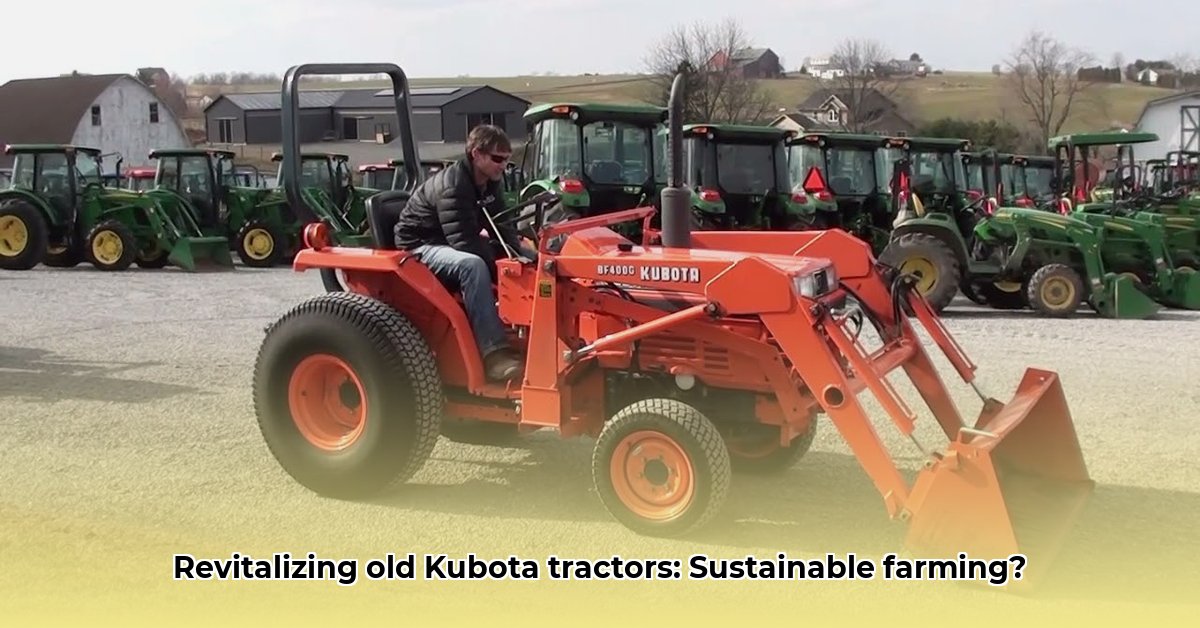
Kubota's Humble Beginnings: Post-War Japan's Agricultural Revolution
The post-war era in Japan presented a unique challenge: rebuilding a nation while ensuring food security. Land was scarce, farms were small, and the need for efficient agricultural machinery was paramount. Kubota's response? Compact, reliable tractors perfectly suited to the needs of Japanese farmers. These weren't the powerful machines we see today; they were innovative solutions for a nation in recovery. Their simple yet robust designs, combined with unparalleled reliability, played a pivotal role in reviving Japanese agriculture, laying the foundation for Kubota's global success. These early models weren't simply machines; they were symbols of hope and resilience. Did the early focus on compactness prove to be a strategic advantage in post-war resource-constrained Japan? For more on early models, see small Kubota tractors.
Technological Leaps: From Simple to Sophisticated
Over the decades, Kubota tractors underwent a remarkable transformation. Early improvements focused on enhancing engine efficiency and increasing horsepower – a direct response to the demands of a growing and evolving agricultural landscape. While precise data on these early upgrades is limited, the evolution is evident in subsequent models. Each design iteration represented a small step forward, culminating in increasingly powerful and sophisticated machines. The addition of features designed to enhance operator comfort and increase productivity further underscores Kubota's commitment to innovation. This evolution showcases the impressive technological advancements achieved by the company; however, more research is needed to comprehensively document the specific technological leaps made during this period. What specific design elements contributed most to the increased efficiency of later models?
Adapting to the Changing Needs of Farmers: Bigger, Better, Stronger
Global agricultural practices shifted significantly over time, demanding larger, more powerful tractors to handle expansive fields and intensified farming techniques. Kubota, ever adaptable, responded by expanding its product line to include larger models while retaining its commitment to quality and reliability. This wasn't a mere scaling-up; it required significant engineering innovation and a deep understanding of market needs. How did Kubota successfully manage this transition while maintaining its hard-earned reputation for dependability? The answer lies in a combination of continuous improvement and a keen understanding of farmer demands. This strategic adaptation contributed significantly to the company’s continued growth and success.
The Growing Importance of Sustainability: A Call to Action
Sustainability is no longer a fringe concern; it's a critical factor in modern agriculture. While comprehensive data on fuel efficiency and emissions for older Kubota models is limited – a gap that necessitates further research – the industry must embrace greener practices. This requires greater transparency, dedicated research, and a commitment to developing eco-friendly technologies. The lack of readily available data on the environmental impact of older models presents a challenge, particularly in assessing their contribution to sustainable farming practices. This lack of comprehensive data highlights the need for improved data collection and reporting across the industry.
Charting a Course Towards a Sustainable Future: Kubota's Ongoing Journey
Kubota's journey, from producing compact tractors to larger agricultural machinery, exemplifies the industry's adaptation to changing demands. The company’s history showcases its ability to innovate and respond effectively to evolving market forces. The future of sustainable agriculture depends on a robust commitment to responsible practices throughout the entire lifecycle of agricultural equipment. This extends beyond efficient engines to encompass sustainable materials, optimized manufacturing processes, and ethical supply chains. What specific actions can be taken to make the agricultural machinery industry more transparent and accountable in its environmental impact?
A Glimpse into Kubota's Evolution: A Timeline of Key Innovations
| Decade | Key Developments | Potential Impacts |
|---|---|---|
| 1960s | Introduction of compact, reliable tractors | Revolutionized post-war Japanese agriculture, increased food production |
| 1970s | Improved engine designs, boosted horsepower | Enhanced productivity, greater efficiency |
| 1980s | Expanded model range, improved operator comfort | Catered to wider range of farming needs, improved working conditions |
| 1990s | Added advanced features, ergonomic improvements | Increased precision and efficiency, improved safety for operators |
| 2000s-Present | Growing focus on fuel efficiency and emissions reduction | Reduction of environmental impact, increased sustainability |
The narrative of old Kubota tractors is more than a technological chronicle; it is a testament to human ingenuity and an ongoing commitment to creating a more sustainable future. The journey continues, and the future of sustainable agriculture rests on our collective commitment to responsible innovation. What innovative technologies can we expect to see in the next decade that may further improve the sustainability of agricultural machinery?